Dalibor Zyka, the inventor of RayFlash ring flash adapter, has recently introduced another product carrying RayFlash brand name. The new gadget is called RayFlash Rotator, an innovative new flash bracket capable of rotating a flash around the camera's lens full 360 degrees.
The main idea behind the design of RayFlash Rotator bracket is to allow photographers easily change the flash position with regards to the camera. Not only you can quickly go from portrait to landscape camera orientation, which is one of the main purposes of any flash bracket, but you can also lock the flash at any angle of your choice. This can be useful for event photography, where you can use various angles for bouncing your flash light off of the objects around you (including some probably exotic scenarios when you might want to bounce off of the floor). Macro photographers might also be interested in this flash bracket, since it allows the flash to be well positioned for macro shots. Combined with various types of bounce and shoot-through (softbox-like) flash diffusers, RayFlash Rotator can be useful in quite a wide range of photography applications.
 |
 |
 |
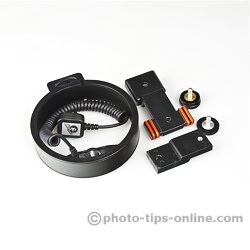 |
Please note that Rotator adds no additional height to your flash. (Extra height is often desirable when flashing directly at the subject.) For the majority of photographers, this should not be an issue, since bouncing techniques offer much better quality of light.
RayFlash Rotator consists of a ring that goes around your lens and a mounting arm that attaches to your camera body. The bracket is shipped with a set of three different arms to fit DSLR bodies of any size, including small and regular bodies like Canon T3i or Nikon D7000, bodies with a battery grip, and large professional bodies like Nikon D3S and Canon 1D series. If you don't often switch from one type of body to another, you are likely to assemble the Rotator once and stash away the rest of the mounting arms, but if you shoot with several bodies of different caliber and want to use RayFlash Rotator with all of them, carrying those arms around may be a hassle. For the majority of users, however, we don't believe this will be a problem.
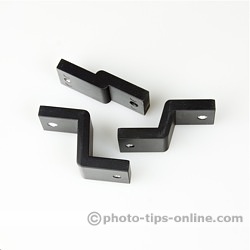 |
The mounting arm has a set of rubber bands that deliver an excellent grip when the bracket is attached to a camera body. Please note, however, that the mounting screw that goes into camera's tripod socket is not attached to the bracket (the hole in the bracket doesn't have a thread). Once you detach the bracket from your camera, the screw falls out. In our opinion, this is unfortunate, because if you don't remember that the screw is not going to stay on the bracket, you are likely to drop and potentially lose it. On the plus side, the mounting screw is quite large and very easy to use.
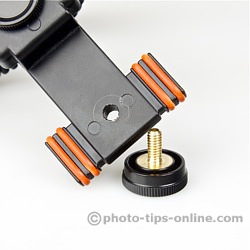 |
Another interesting element of the design is to have a TTL cord built into the flash bracket. While this can be seen as a nice extra, which frees you from carrying a separate cord around, there is a number of drawbacks. Having a built-in TTL cord limits the use of the RayFlash Rotator to one system (currently only Canon and Nikon platforms are supported). Even if you are not shooting with multiple systems, this makes it harder to resell the bracket. Also, if the cord fails for any reason, it is likely that you'll have to replace the whole unit, not just the cord.
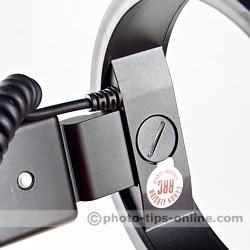 |
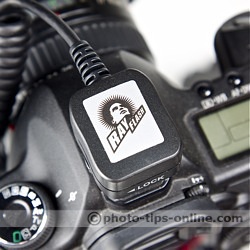 |
Despite the mentioned quirks, in practice, RayFlash Rotator is quite versatile. It is well-built and feels very solid in use. It is relatively compact when assembled and, if necessary, can be quickly taken apart to occupy even less space in your gear bag (we, however, prefer having it assembled at all times). The bracket weighs about 18 oz (500 grams), which is roughly the weight of Canon Speedlite 580EX II with the batteries. The following image shows the Rotator side-by-side with Demb Flash Bracket, one of the smallest and lightest flash brackets on the market.
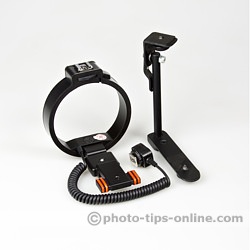 |
We found that the positioning lock, indeed, allows you adjusting flash position quickly and easily. In fact, in certain cases, we prefer adjusting the flash position on the bracket rather than turning the flash head (assuming that the same bounce effect can be achieved).
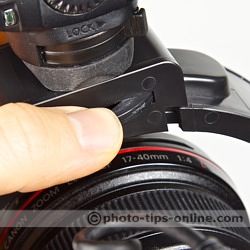 |
It is worth mentioning that RayFlash Rotatorshifts the weight of your whole rig forward, which more noticeable with heavier flashes and lighter camera bodies. To our taste, a combination like Canon EOS 60D and Speedlite 580EX II already makes this effect less prominent. Using a larger body or a battery grip makes it feel even less off-balance.
Originally, we've been a bit worried about changing lenses while having the Rotator on. After using it for a while, we believe it is not really a concern. Lenses can be inserted into the bracket's ring and then into the lens mount. While not ideal, this works reasonably well.
Since the ring of the RayFlash Rotator sits around your lens, you might wonder if it blocks any of the lens controls. While this, of course, depends on the size of the lens you are using and the size of your hands, we believe that in most situations, all lens controls, including switches, zoom, and focus rings, are reasonably accessible.
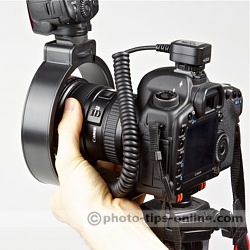 |
To summarize, below is the list of pros and cons:
Pros:
Cons:
Other things to consider:
RayFlash Rotator flash bracket, while not perfect, brings an interesting concept to the market. It can be a good choice for event and portrait photographers. Users focused on macro applications may also benefit from this new bracket. Hopefully, our analysis here will help you to make the right buying decision.